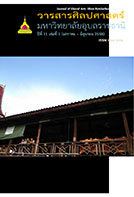รูปแบบการจัดการท่องเที่ยวเชิงศาสนาและวัฒนธรรมในวัด
Main Article Content
บทคัดย่อ
อัตลักษณ์การจัดการท่องเที่ยวในวัดภาคเหนือ มีพัฒนาการมาตั้งแต่การเดินทางจาริกแสวงบุญเพื่อกราบนมัสการพระบาทพระธาตุตามตำนานพระเจ้าเลียบโลกและคติความเชื่อเรื่องชุธาตุ ในยุคปัจจุบัน การท่องเที่ยวเป็นไปเพื่อตอบสนองรูปแบบการใช้ชีวิตของคนมากขึ้น รวมไปถึงการตีความหมายใหม่ของรูปแบบการท่องเที่ยวที่มีความหลากหลายตามการเปลี่ยนแปลงของสังคม
ผลกระทบของการท่องเที่ยวที่มีต่อวิถีชีวิตและวัฒนธรรมของวัดในภาคเหนือพบว่า 1) ปัญหาความเสื่อมโทรมของวัดที่เป็นแหล่งท่องเที่ยวภาคเหนือ บางแห่ง 2) ปัญหาด้านสาธารณูปโภคและสวัสดิภาพของนักท่องเที่ยว 3) ปัญหาการรักษาเอกลักษณ์ทางวัฒนธรรม 4) ปัญหาด้านการจัดการท่องเที่ยว และ 5) ปัญหาการมีส่วนร่วมในการบริหารจัดการโดยท้องถิ่น
แนวทางในการจัดการท่องเที่ยวเชิงศาสนาและวัฒนธรรมของวัดในภาคเหนือ มีประเด็นสำคัญ 4 ประเด็น คือ 1) การจัดการด้านพื้นที่ มีการจัดทำผังการใช้สอยพื้นที่ของวัดตามบทบาทหน้าที่ 2) การจัดการด้านแผนพัฒนา มีการจัดทำแผนพัฒนาวัดทั้งในระยะสั้นและระยะยาว 3) การจัดการด้านบุคลากรมีกระบวนการจัดการบุคลากร และ 4) การจัดการด้านระบบการสื่อความหมายเนื้อหา
Religious and Cultural Tourism Management Model in Buddhist Temple
The research entitled “Religious and Cultural Tourism Management Model in Buddhist Temple” consists of 2 objectives as 1) to study the identity of Buddhist tourism in northern Thailand and 2) to study the guideline of religious and cultural tourism in northern Thailand. The result revealed as follows.
The identity of tourism management in northern Thailand, it had been developed from the pilgrimage according to the legend of Phra Chao Liap Lok or the Buddha’s Journeys in order to respect the Buddha’s footprint. In addition, it was also developed from the belief of the Chuthat – the stupa associated with the twelve year cycle. At present, the tourism was designed to meet the lifestyle of people with the new interpretation of tourism based the social diversities.
The impact of tourism to the lifestyle of northern people, it can be found as follows: 1) there were found the degenerative of some temples, 2) Infrastructure problems and welfare of tourists, 3) the problem of cultural identity, 4) the problem of tourism management and 5) the problem of local administration.
The guideline of religious and cultural tourism management in northern Thailand, it can be summarized into 4 aspects as: 1) the area management, 2) the management of temples in long and short term, 3) the personnel management and 4) the management of communication system.


